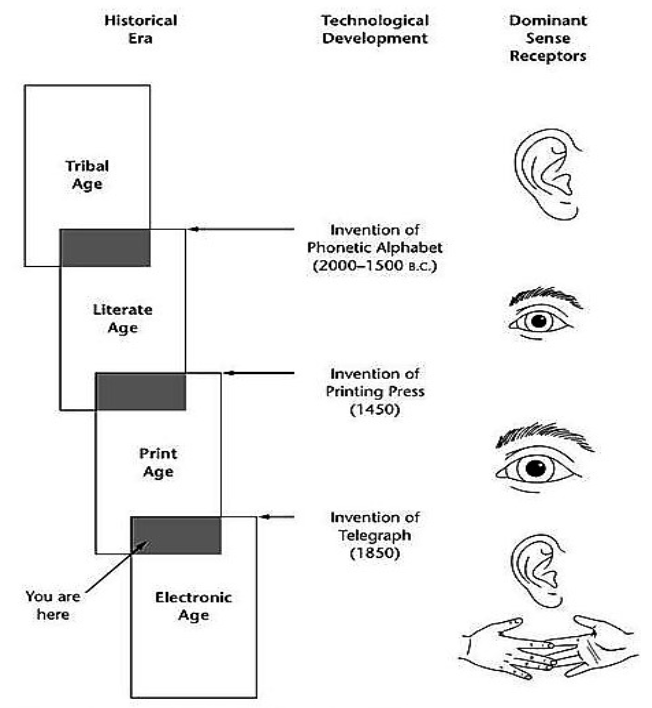MIL ETA
1/42
There's no tags or description
Looks like no tags are added yet.
Name | Mastery | Learn | Test | Matching | Spaced |
|---|
No study sessions yet.
43 Terms
Media
All human-invented technology that extends the range, speed, or channels of communication
Medium
Specific type of media (i.e. books, radio, email)
Ecology
Environment where the medium is used, what they are, and how they affect society
Media Ecology
Study of different personal and social environments created by the use of different communication technologies. Also refers to the evolution of the medium
Herbert Marshall McLuhan
Proponent of the Evolution of Media, was a pioneering media theorist, studied the relationship between media and culture, predicted the world wide web almost 30 years before it was invented
Mcluhan’s Media Map of History

Evolution of Media
Tribal Age, Age of Literacy, Print Age, Electronic Age, Digital Age
Tribal Age
Before 1700. Primary medium was oral communication. Dominant sense receptor was hearing. Personal interaction and attention are evident. People led richer and complex lives compared to their descendants.
Age of Literacy
Dominant sense receptor was sight. Literacy triggers an ear-to-eye switch that isolates the reader. Words fixed on a page detach from the meaning of the immediacy of context. People became independent learners.
Print Age
Dominant sense receptor was sight. Dated to the invention of the movable type mechanical printing press (1930s-1970s). Visual dependence became widespread. Printing press was the extension of phonetic literacy.
Electronic Age
Dominant sense receptors are hearing and touch. With the telegraph, the power of the printed world started to decline. People became a global village/singe tribe. Constant contact became a reality. What we feel is more important than what we think. People are more informed about internation events.
Digital Age
Digital technology is altering the electronic environment. Electronic data is becoming more personalized. A lot of digital tribes are forming around ideas, beliefs, values, interests, and fetishes. Digital media is altering our present environment. Allows for father communication and creation of social networks.
Agenda
Underlying ideological plan
Setting
Manner or direction in which something is set
Theory
Scientifically acceptable general principle or body of principles offered to explain phenomena
Agenda Setting Theory
Ability of news media to influence the importance places on the topics in the public agenda
Media’s Main Goal in Agenda Setting Theory
Inform us on what they believe is important issues to our society. Push the public into a specific kind of thinking.
Media Agenda
Repetition and consistent prominence attached to an issue to elevate it higher. Media focus on topics that are deemed newsworthy.
Agenda Setting Proponents
Maxwell McCombs & Donald Shaw
Organization of Media
Truth > Media Gatekeepers > Media Agenda/Reality > Framing of Stories
Framing of Stories
This determines the salience of a story. Process involves selection, omission, emphasis, and/or elaboration
Framing Theory
How an issue is presented to the audience influences the choices people make about how they process information. Second step in agenda setting. Helps boost media attention.
Framing Theory Proponents
Gregory Bateson and Erving Goffman
Agenda vs Framing
Agenda = influences what we think about
Framing = influences the way we think about something
Types of Framing
Positive and Negative Framing
Semiotics
Study of signs, symbols, and meanings
Semiotics Proponents
Ferdinand De Saussure and Roland Barthes
Signifier
The image, object, or sound itself
Signified
The concept it represents
Referent
The which is outside the test is excluded in the semiotic process
Advertising
Impersonal communication of information about products, services, or ideas through media. Usually persuasive and paid by identified sponsors.
Famous Person Testimonial
Product endorsed by a well-known person
Plain-Folks Pitch
Associates a product with simplicity
Social Appeal
Gives the audience a sense of social acceptance. Focuses on finding joy in friend-making, feeling included, increasing in status, or being affiliated with a particular group.
Romance Appeal
Focuses on relationships. Product will enhance the romance and relationship like a portrayed couple. Effective when there is perceived weakness in a couple’s relationship.
Scarcity Appeal
Effective when things are time-sensitive and can sell out. Product/sale usually will only last a short time
Snob Appeal
Using the product will maintain or elevate their social status
Bandwagon Effect
Suggesting you should join the crowd by buying the product
Emotional Appeal
Uses emotions to encourage their audience to take action
Because of Advertising…
Products become “fetish objects'“. Individuals start to measure their self-worth and worth of others in terms of the value of the goods they possess. Capitalists have a means to control and manipulate our needs and desires.
Culture Industry
Popular culture in capitalist society functions like an industry, producing standardized products that lead to standardized people. It highlights the uniformity and false uniqueness of cultural items, which are carefully regulated.
Main Concerns about the Culture Industry
Dark side of modernity, commodity fetishism, false consciousness created by the dominant classes and the media
Culture Industry Proponents
Theodor Adorne and Max Horkheimer